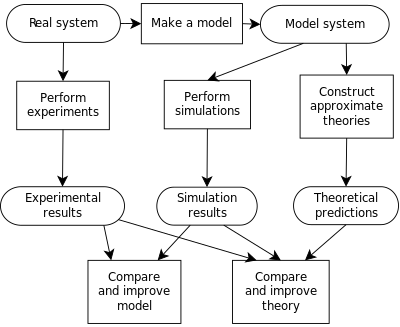
Back محاكاة بالحاسوب Arabic Компютърна симулация Bulgarian Simulació d'ordinador Catalan Počítačová simulace Czech Computersimulation Danish Computersimulation German Komputilsimulado Esperanto Simulación (informática) Spanish Arvutisimulatsioon Estonian شبیهسازی کامپیوتری Persian
This article needs additional citations for verification. (December 2022) |


Computer simulation is the running of a mathematical model on a computer, the model being designed to represent the behaviour of, or the outcome of, a real-world or physical system. The reliability of some mathematical models can be determined by comparing their results to the real-world outcomes they aim to predict. Computer simulations have become a useful tool for the mathematical modeling of many natural systems in physics (computational physics), astrophysics, climatology, chemistry, biology and manufacturing, as well as human systems in economics, psychology, social science, health care and engineering. Simulation of a system is represented as the running of the system's model. It can be used to explore and gain new insights into new technology and to estimate the performance of systems too complex for analytical solutions.[1]
Computer simulations are realized by running computer programs that can be either small, running almost instantly on small devices, or large-scale programs that run for hours or days on network-based groups of computers. The scale of events being simulated by computer simulations has far exceeded anything possible (or perhaps even imaginable) using traditional paper-and-pencil mathematical modeling. In 1997, a desert-battle simulation of one force invading another involved the modeling of 66,239 tanks, trucks and other vehicles on simulated terrain around Kuwait, using multiple supercomputers in the DoD High Performance Computer Modernization Program.[2] Other examples include a 1-billion-atom model of material deformation;[3] a 2.64-million-atom model of the complex protein-producing organelle of all living organisms, the ribosome, in 2005;[4] a complete simulation of the life cycle of Mycoplasma genitalium in 2012; and the Blue Brain project at EPFL (Switzerland), begun in May 2005 to create the first computer simulation of the entire human brain, right down to the molecular level.[5]
Because of the computational cost of simulation, computer experiments are used to perform inference such as uncertainty quantification.[6]
- ^ Strogatz, Steven (2007). "The End of Insight". In Brockman, John (ed.). What is your dangerous idea?. HarperCollins. ISBN 9780061214950.
- ^ "Researchers stage largest Military Simulation ever". Jet Propulsion Laboratory. Caltech. December 4, 1997. Archived from the original on 2008-01-22.
- ^ "Molecular Simulation of Macroscopic Phenomena". IBM Research - Almaden. Archived from the original on 2013-05-22.
- ^ Ambrosiano, Nancy (October 19, 2005). "Largest computational biology simulation mimics life's most essential nanomachine". Los Alamos, NM: Los Alamos National Laboratory. Archived from the original on 2007-07-04.
- ^ Graham-Rowe, Duncan (June 6, 2005). "Mission to build a simulated brain begins". New Scientist. Archived from the original on 2015-02-09.
- ^ Santner, Thomas J; Williams, Brian J; Notz, William I (2003). The design and analysis of computer experiments. Springer Verlag.